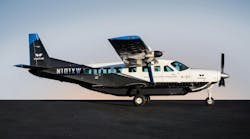June 19--EGLIN AFB -- After nearly three years of review and revision, the final draft of a report analyzing the environmental impacts of the F-35 program at Eglin Air Force Base has been released.
The first draft of the environmental impact statement was released in September 2010. The Air Force decided to scrap the first draft and wait for some additional studies that were in the works before creating a new one.
The report is now available for public review and comment through July 29. It then will be sent to the Secretary of the Air Force's office for final approval.
"I'm happy to have this out on the streets and I hope to move on and get a decision as soon as possible," said Larry Chavers, chief of environmental planning for Eglin, who has been working on the report.
The F-35 Joint Strike Fighter program at Eglin is the training ground for all flight and maintenance students across all branches of the military and several partner nations. Flight operations began in 2012, but the Air Force left some restrictions in place until more information could be gathered about how the program would affect the base, surrounding communities and the environment.
The restrictions included limiting flights on the base's runway that sends air traffic over nearby Valparaiso. Residents and business owners have expressed concern about noise from the jets.
The environmental impact statement provides several alternatives on how to allow the program to ramp up operations as more aircraft arrive and more students go through the training.
Lifting the restrictions on the runway -- the only proposal that does not require additional construction -- is the Air Force's preferred alternative, as it was in 2010, according to the report.
"This seems to be a fairly logical use of existing infrastructure," said Mike Spaits, environmental spokesman for Eglin.
It doesn't require construction of an additional runway, taxiway or buildings, won't require destruction of habitat of any endangered or threatened species, won't interrupt any recreation on the base's reservation, and keeps most flight operations close to where the academic training center is located.
However, that proposal would mean more people and more homes could potentially be affected by noise than any of the other plans, according to the report.
The six other alternative plans include building a new runway at Eglin or at Duke Field. Those plans would result in an increase of 15 to 25 additional homes exposed to sound levels more than 75 decibels.
Lifting restrictions on the runway that sends jets over Valparaiso could result in an increase of about 180 homes exposed to noise at that level, the report said.
Spaits said the total increase of homes potentially exposed to noise levels over 75 decibels with the F-35 program is only about 500 more than when officials analyzed the impact of the F-15s that once were stationed at Eglin. Considering the breadth of the program, that's a relatively small number, he said.
The new draft contains information about the F-35 program that wasn't available in 2010, including a new noise profile for the jet and a revised operating plan for the training program.
It's based on operating with 59 aircraft, the maximum allowed at Eglin. The base now has 25 F-35s.
The new information resulted in an estimate of about 24,000 fewer flights a year, from 114,000 in 2010 to about 90,000 in the latest draft.
"We know more about the aircraft, how we're flying and we've actually done some training operations," Chavers said.
As a result, he said the noise impact estimates across the board dropped by 2 to 3 decibels, a significant reduction.
Also, in response to an analysis of the air space over Eglin, F-35 training involving simulating an engine burnout and an emergency landing will be done primarily at Tyndall Air Force Base, where noise impacts and potential disruption of civilian aircraft operations is limited.
Of the 90,000 estimated annual flight operations at the program's peak, only about 44,000 would take place at Eglin. Of those flights, only about 6 percent would occur on the runway that sends aircraft over Valparaiso, Spaits said.
Also, night flights have been reduced from 5 percent to 3 percent.
After the first draft was released in September, three public hearings were held on the proposal. More than 400 comments were submitted, primarily dealing with noise issues.
Those comments have been addressed in the revised proposal, and some were implemented in the new draft.
A public hearing on the latest draft statement will be July 9 in Valparaiso.
"As a good neighbor we wanted to make sure Valparaiso has all the new data and the community has the opportunity to comment again," Spaits said.
People also can submit comments in writing.
Chavers noted that although the Air Force has chosen its preferred alternative, it does not mean that will be the final plan for moving the F-35 program forward.
The Air Force will study public comments submitted as part of the review process, he said.
WANT TO ATTEND? A public hearing on the revised draft of the environmental impact statement will be from 5:30 to 8 p.m. July 9 at First Baptist Church of Valparaiso. Written comments also can be submitted to Mike Spaits, Eglin Air Force Base Public Affairs Office, 101 West D. Avenue, Suite 236, Eglin Air Force Base, FL 32542-5499, by phone at 882-2836 or by email at [email protected].
Contact Daily News Staff Writer Lauren Sage Reinlie at 850-315-4443 or [email protected]. Follow her on Twitter @LaurenRnwfdn.
Copyright 2013 - Northwest Florida Daily News, Fort Walton Beach





